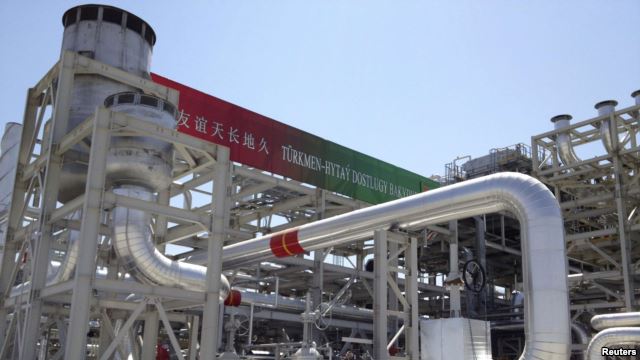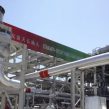
Turkmenistan Complains Gazprom Is Not Paying Its Bills
Publication: Eurasia Daily Monitor Volume: 12 Issue: 132
By:

On July 8, Turkmenistan’s Ministry of Oil and Gas noted that Russian state natural gas company Gazprom had failed to pay for imports since the beginning of the year, stating, “The Russian company OAO Gazprom has failed to pay under its contracts for buying and selling natural gas, due to the continuing global economic crisis and imposed economic sanctions by Western countries against Russia. From the beginning of 2015 OAO, Gazprom has not paid its debts to the Turkmengaz State Corporation for the supplied volumes of Turkmen natural gas” (GK Turkmengaz, July 8). The announcement is but the latest twist in a strained relationship that dates back to the 1991 collapse of the Union of Soviet Socialist Republics (USSR).
When Turkmenistan unexpectedly gained independence in 1991, the country’s leader, Saparmurat Niyazov, had already been in power since 1985. Turkmenistan had inherited the second largest natural gas reserves in the Soviet Union, exceeded only by Russia. Nizyazov, who would later style himself “Turkmenbashi,” chafed after 1991 at being forced to sell Turkmenistan’s natural gas to the Russian Federation’s state-owned firm Gazprom for prices far below world market rates, which Gazprom would then charge its foreign customers. Niyazov considered other options and, in March 1997, halted gas exports to Gazprom, opening later that year the $195 million, 124-mile, 8.4-billion-cubic-meter (bcm) annual capacity Korpezhe-Kurt Kui pipeline to Iran. This was Central Asia’s first gas export pipeline that bypassed Russia, and the region’s first southern export pipeline (Turkmenistan.ru, September 14, 2005).
Since the death of Niyazov in December 2006, his successor, Gurbanguly Berdimuhamedov inherited his problems with Gazprom. In 2008, Berdimuhamedov, along with Kazakhstani President Nursultan Nazarbayev and Uzbekistani President Islam Karimov, presented a united front to Gazprom, demanding higher payments as world prices were rising to record highs, to which Gazprom reluctantly agreed (Vremia Novostei, April 14, 2009).
The USSR had spun a network of export pipelines in the Central Asian region—most notably, the Truboprovodnaiia Sistema Sredniaia Aziia-Tsentr (SATS) network, which ran northward to bring gas pumped in the Turkmen Soviet Socialist Republic (SSR) via the Uzbek and Kazakh SSRs to the Russian Soviet Federative Socialist Republic (RSFSR). The SATS eastern branch consists of SATS-1, 2, 4 and 5 pipelines, which were built between 1960 and 1988. Construction began after the discovery of the Dzharkak field in the Turkmen SSR, with the first SATS section coming online in 1960; SATS-4 was commissioned in 1973. Accordingly, after the breakup of the USSR, the initial viable export options for newly independent Azerbaijan, Kazakhstan, Turkmenistan and Uzbekistan remained the Soviet-era export pipeline networks directed toward Russia. But all these new post-Soviet non-Russian republics chafed under Moscow’s “buy cheap and sell dear” policies toward their hydrocarbons (Gazprom.ru, accessed July 15; Silkroadreporters.com, February 11).
Until 2009, Gazprom and Turkmenistan needed each other. Gazprom is the world’s biggest gas company, controlling 72 percent of Russia’s reserves and 16.8 percent of the global total (BP Statistical Review of World Energy, June 2014). In 2013, its production of 487 bcm of natural gas overtook ExxonMobil and Shell, as did its exports of 233.7 bcm—12 percent of Russia’s total exports of goods and services. Gazprom has a major advantage thanks to the low production costs in the market. More than half of Gazprom’s output is sold on the domestic market, and it plays an important part in ensuring Russia’s economic and social stability. Accordingly, the Russian energy giant needed Central Asian gas for export, but the 2008–2009 global financial crisis heavily cut into Gazprom’s profits when energy prices declined due to the economic slowdown and resulting drop in global demand.
Turkmenistan’s natural gas reserves are estimated at 13.4 trillion cubic meters and, up until 2009, it had two export options—Russia or Iran (BP Statistical Review of World Energy, June 2014). However, on April 9, 2009, Gazprom unilaterally and drastically cut its imports of Turkmenistani gas, causing an explosion at the 302-mile segment of the SATS-4 Davletbat-Daryalik pipeline between the Ilyaly and Deryalyk compressor stations near the border between Turkmenistan and Uzbekistan. The blast halted Turkmenistan’s natural gas exports to Russia, which, until then, had been running at 42–45 bcm per annum (Newsru.com, April 9, 2009).
The following day Turkmenistan’s Ministry of Foreign Affairs blamed Russia for the pipeline explosion and subsequent conflagration that halted the country’s gas exports (RFE/RL, April 14, 2009; Mid.ru, April 10, 2009). Gazprom subsequently demanded that Turkmenistan either reduce its gas shipments by 80 percent or its price by 40 percent (“Turkmenistan: Real Energy Giant or Eternal Potential?” Harvard University’s Belfer Center and Rice University’s Baker Institute Center for Energy Studies, December 10, 2013, p.17).
When Turkmenistan’s natural gas exports to Russia finally resumed in January 2010, they did so at a much lower level, about 10 bcm annually, and at a lower price: they had been roughly $300 per thousand cubic meters (tcm) in the first quarter of 2009 prior to the explosion, dropping to less than $200 per tcm through 2010 (Lenta, January 9, 2010). The factor undoubtedly driving Gazprom’s policies was the fact that Turkmenistan was now reaching out to a new customer—China.
Gazprom’s earlier heavy-handedness impelled Turkmenistan to look east for customers and led Niyazov, in April 2006, to sign a deal with China for a Turkmenistan-China natural gas pipeline capable of handling 30 bcm annually. The China National Petroleum Corporation (CNPC) began construction of the Central Asia–China pipeline, which opened in December 2009. Other pipelines have come online since then, and China has agreed to purchase 65 bcm of Turkmenistani gas annually, effectively squeezing Gazprom out of Turkmenistan’s market. But the China-Turkmenistan gas deal is opaque, with prices quoted between $250 and $195 per tcm, the latter representing roughly half of current world market prices (Azernews.az, May 8, 2015; RFE/RL, December 10, 2014).
The rift between Gazprom and Turkmenistan appears permanent, but Ashgabat has issues over its contracts with China as well. Seeking to diversify its markets, Turkmenistan is actively promoting a subsea Caspian pipeline to Azerbaijan, in order to eventually tap into Western markets. But to do so will require the assent of another Caspian nation—Russia—which will hardly look happily on the loss of its most lucrative market share. For the foreseeable future then, Turkmenistan and Gazprom will continue to act like two scorpions in a bottle.




